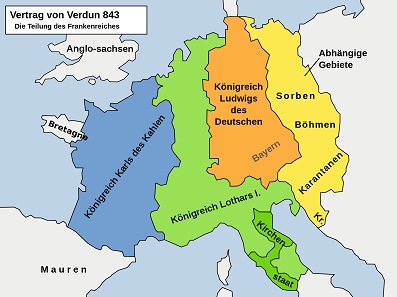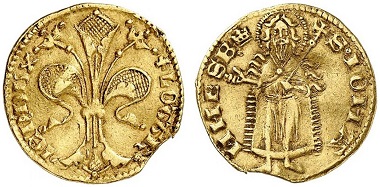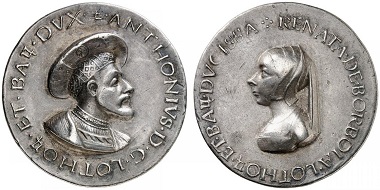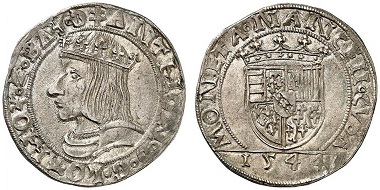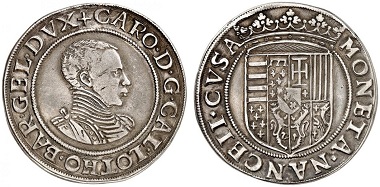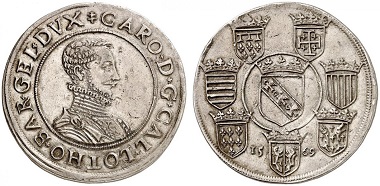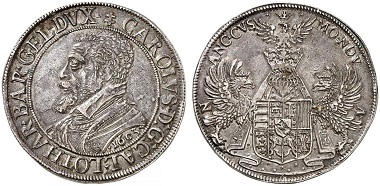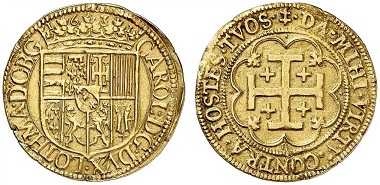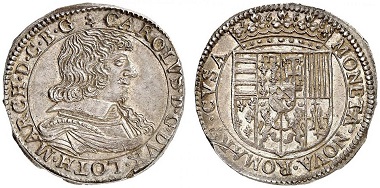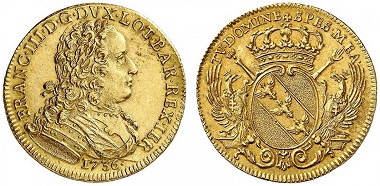Everything started with the Treaty of Verdun in the year 843. With this treaty, Lothar, the oldest son of Louis the Pious was given both the imperial title and a certain part of the empire, often humorously described as the ‘bowling alley’ by German historians. It actually stretched from the North Sea all the way down to the Mediterranean and it entailed both the economically strong Rhineland and the imperial city of Rome. The two younger brothers got West Francia, which would later turn into France, and East Francia, the origin of the Holy Roman Empire.
The division of the Carolingian Empire in the Treaty of Verdun. Source: Christoph S., Wolpertinger / CC BY-SA 3.0
It was a shame that Lothar had three sons, whom he gave equal shares of his empire adhering to Frankish law. It was an even greater shame that they all died without heirs. Lothar II left Lorraine, named after him, which was a bone of contention between West- and East Francia from the very start and would later become one between France and Germany.
Lorraine. Jean I, 1346-1390. Florin d’or n. y. From Grün sale 71 (2017), No. 1813. Estimate: 3,500 Euro
Let’s jump to the 14th century. It was at that time that Lorraine got its final shape. The northwestern territory, called Lower Lorraine, fell apart into Limbourg, Jülich and Brabant; the Duchy of Bar separated from the southeastern Upper Lorraine. Metz, Toul and Verdun got the legal status of free imperial city. The rest became the Duchy of Lorraine with Nancy as capital and centre.
Lorraine. René II, 1473-1508. Florin d’or n. y., Nancy. From Grün sale (2017), No. 1820. Estimate: 7,500 Euro
In 1473 René II inherited the duchy and it was just the right moment. Incidentally, the Burgundian Charles the Bold had conquered the old Lower Lorraine and would have loved to extend his power to Upper Lorraine, too. But by doing so, he got in the way of the French king. Louis XI is sometimes called ‘the Universal spider’ because he created a net of alliances just like a spider, which would later catch Charles the Bold. And René II with his threatened Lorraine, was not the only ally of Louis, he also had the Swiss. They annually received 20,000 florins for their military support, which would increase to 20,000 florins every three months in times of war. This was an efficient incentive to intervene. And so it came to pass that Charles the Bold lost his possessions at Grandson, his confidence at Murten and his life in Nancy (in Switzerland this is a doggerel every child used to know: Bei Grandson verlor er sein Gut, bei Murten den Mut und bei Nancy das Blut). René II was actually involved in Charles’ death. Charles died when René relieved his capital with 8,000 confederate mercenaries in 1477.
Lorraine. Antoine the Good, 1508-1534, with his spouse Renée de Bourbon-Montpensier, 1494-1539. Medal from Matteo del Massaro. From Grün sale 71 (2017), No. 1840. Estimate: 2,500 Euro
René’s oldest son Antoine inherited Lorraine in 1508. He was raised at the French court and he was a loyal liegeman of Louis XII at first and then of his son Francis I. Antoine fought at Agnadello and Marignano. He did not fight in the Battle of Pavia which cost the lives, health or freedom of two thirds of the French armed forces. He had got lucky: His subjects revolted in the Peasants’ War and therefore he had to stay in Lorraine to subdue them. At the Battle of Sélestat on 20 May 1525, around 30,000 peasants died by the command of Antoine “the Good”.
Lorraine. Antoine the Good, 1508-1534. Teston 1544, Nancy. From Grün sale 71 (2017), No. 1838. Estimate: 400 Euro
Lorraine was important in the war between Francis and Charles, which is why the emperor – due to Antoine’s neutrality in the Treaty of Nuremberg 1542 – granted Antoine the actual independence of Lorraine from the Holy Roman Empire.
Lorraine. Charles III, 1545-1608. Écu n. y. (1556-1561), Nancy. From Grün sale 71 (2017), No. 1845. Estimate: 5,000 Euro
In 1545, Charles III ascended to the throne. He was only two years old. Therefore his mother, Christina of Denmark, took over the reign. She was the niece of Charles V and she sided more with the emperor.
Lorraine. Charles III, 1545-1608. Écu 1569, Nancy. From Grün sale 71 (2017), No. 1846. Estimate: 3,500 Euro
This was certainly not in the French king’s interest. Although he was Catholic, he still supported the cause of the Protestants, the enemies of his enemy Charles V. In the Treaty of Chambord, Henry II of France and Maurice of Saxony agreed that the Schmalkaldic League would receive 70,000 gold crowns every month for their fight against the emperor. As a small compensation, Maurice declared Henry imperial vicar of the Lorraine imperial cities Toul, Verdun, Metz and Cambrai.
Metz, Bistum. Robert de Lenoncourt, 1551-1555. Écu 1551. From Grün sale 71 (2017), No. 2021. Estimate: 6,000 Euro
This however was neither legal nor legitimate nor even fair, but Henry II had an army and he used it to conquer Toul, Verdun and Metz. Protesting cardinals like Robert de Lenoncourt were generously reimbursed. The three imperial cities became the French province Trois-Évêchés (or ‘Three Bishoprics’).
Lorraine. Charles III, 1545-1608. Taler 1603, Nancy. From Grün sale 71 (2017), No. 1865. Estimate: 4,000 Euro
Christina of Denmark was not compensated but removed. Henry appointed a Francophile regent and thus got matters of Lorraine sorted out according to his instructions. He took the nine-year-old Charles to Paris with him in order to raise him at court as he saw fit. It was only in 1559 that Charles III returned to Nancy. He had married a daughter of Henry II of France. He would never have taken action against the French king again if had not been for a Huguenot, of all people, who lay claim to the throne.
Lorraine. Charles III, 1545-1608. Double pistole n. y. (1581-1608). From Grün sale 71 (2017), No. 1867. Estimate: 10,000 Euro
Charles was a convinced Catholic; he could not accept a Huguenot as king. Consequently he propagated his own decent from Charlemagne so that he could lay claim to the French throne as well. Charles III did not prevail, but he bid for the throne so well that his son and successor, Henry II, was given the sister of the new king as wife and Charles raked in 2,700,00 livres as father-in-law. No wonder that Lorraine flourished under Charles III!
Lorraine. Charles IV and Nicole, 1624-1625. Teston 1624, Nancy. From Grün sale 71 (2017), No. 1879. Estimate: 125 Euro
Henry II, Duke of Lorraine, had no sons. That is why he appointed his daughter Nicole as his heir. But Henry’s brother, Francis II, objected and lay claim to the duchy as the next male heir. As a kind of compromise, the brothers decided to marry Nicole to the son of Francis, Charles IV. Not a great solution.
Lorraine. Charles IV, 1625-1634. Double pistole 1631. From Grün sale 71 (2017), No. 1880. Estimate: 10,000 Euro
Charles IV would then only have governed as the husband of Nicole. The Lorraine Estates-General recognised Francis, the deceased duke’s brother, as heir. He accepted and stepped down five days later for the benefit of his son Charles. The only problem left was the issue of the unloved wife. The attempt to declare their marriage void, because Nicole supposedly was a witch failed – as did Francis’ efforts to get the pope to annul the marriage.
Lorraine. Charles IV, 1638-1639, mint from exile. Teston 1638, Remiremont / Vosges. From Grün sale 71 (2017), No. 1884. Estimate: 400 Euro
The French king used this legal uncertainty to invade Lorraine with his troops. Charles VI tried to get his duchy back. But even though it seemed like he would succeed from time to time, he eventually failed. When he died, the king of France still occupied Lorraine.
Lorraine. Leopold, 1690-1729. Écu 1702. From Grün sale 71 (2017), No. 1892. Estimate: 5,000 Euro
The next ruler of the duchy was called Leopold Joseph, Duke of Lorraine and he was a grandson of Charles IV. And that is not all! Since his father – the ‘Duke without a duchy’ – had been one of the most famous marshals of the emperor, the latter had honoured him by giving him his own daughter’s hand in marriage. Thus Leopold was also a grandson of the German emperor. Leopold owes his return to Lorraine to the Treaty of Ryswick 1697. But he did not have much time left. It was already in 1702 that Louis XVI occupied Nancy. Leopold got comfortable in Lunéville, which has come to be known as the Versailles of Lorraine.
Lorraine Francis I, Duke of Lorraine, 1729-1737. François d’or 1736. From Grün sale 71 (2017), No. 1984. Estimate: 7,500 Euro
We do not need to say all that much about his son. Everyone knows him. It was Francis, husband of Maria Theresa of Austria. His duchy was used like bargaining chips in the search for acceptance of the pragmatic sanction. The French king accepted that Maria Theresa followed her father to the throne. In exchange, Francis offered his duchy to the failed Polish king Stanislaw I Leszczynski. Francis got Tuscany as compensation. After Leszczynski’s death, Lorraine was given back to the French king. Since Leszczynski had not been granted the right to mint coins, the Lorraine coinage ended with Francis I.
Lorraine would change possession several times after that: In 1871, after World War I and World War II. It practically became the epitome of the German-French conflict. The European Union has given Peace to this region which has been tormented by war time and again. This period of peace has already lasted for more than 70 years – longer than ever before in the history of Lorraine.
You can find all coins of the auction on Sixbid.
We have published an auction preview of all the material.
And here you will find the Heidelberger Münzhandlung.





